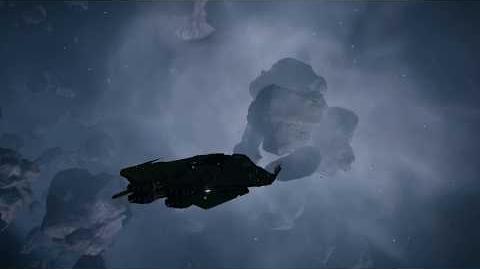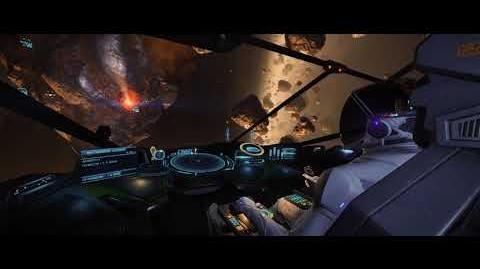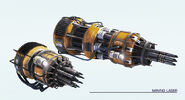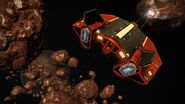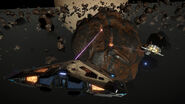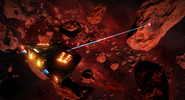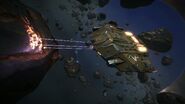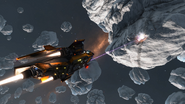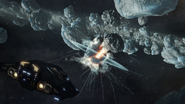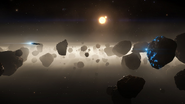Miners extract metals, minerals, and other resources from asteroids and sell them for profit. Mining involves traveling to potential sites in space, usually pristine Planetary Rings, identifying specific resource-rich asteroids, and using various specialized Hardpoint modules to remove and collect their resources.
In order to begin mining, pilots require three essential optional internal modules: a Refinery to refine collected resources into Commodities for sale, one or more Cargo Racks to carry the refined Commodities, and one or more Mining Lasers, Abrasion Blasters, Sub-surface Displacement Missiles, or Seismic Charge Launchers. The Detailed Surface Scanner, Prospector Limpet, and Pulse Wave Analyser can also be equipped to more easily locate ideal mining sites and valuable asteroids, and the Collector Limpet can be used to more efficiently gather raw resources. Miners who choose to delve inhabited systems rather than uncharted ones can purchase system data from Universal Cartographics or scan a Navigation Beacon in order to determine the quality of a system's asteroid clusters or planetary rings.
Some miners prefer small, nimble ships for mining, as they are better at maneuvering around asteroids, in tight asteroid belts and rings at higher velocities. However others prefer larger ships such as the Python, Imperial Clipper, Federal Corvette, Imperial Cutter and the Anaconda, which are not as maneuverable, but can equip all the beneficial Limpet Controllers and carry a large number of limpets for their use, while still having room for cargo and shields, increasing efficiency. Additionally, the larger ships are better at defending themselves from pirates while mining, though such threats can generally be avoided in the uncharted systems beyond human habitation centers.
Ships
An ideal mining ship requires at least one Class 2 hardpoint to fit larger mining tools for more efficient or profitable mining, and enough optional internal slots to hold a Refinery, a Collector Limpet Controller, a Prospector Limpet Controller, a Detailed Surface Scanner, and at least one Cargo Rack. Mobility is also an important factor, due to needing to find more specific asteroids, and aiming certain mining tools. At least 4 hardpoints, with one medium, are required to hold one of every mining tool. A Fighter Hangar is also recommended, as it lets a ship defend against pirates while its hardpoints are replaced with mining tools.
- A great choice for new miners is the Cobra MkIII, due to the size of its cargo hold, internal compartments, and its maneuverability. It can also fit the Class 2 mining tools.
- The Adder is the earliest ship capable of efficient mining, as it can equip three mining lasers, as well as being the earliest deep core mining ship as it has one Class 2 hardpoint. It has decent capacity but won't be able to defend itself.
- The Keelback can equip multiple lasers and has a half-decent capacity, and can use a fighter hanger for self-defense. It also has the required 4 hardpoints for every mining tool.
- The Asp Explorer is an excellent stepping stone between the small and medium ship sizes, and is a capable and highly profitable deep core mining ship.
- The Krait MkII and Krait Phantom are more expensive medium options for mining, but can comfortably fit all necessary mining tools and modules. The larger MkII can also hold a fighter bay for added protection, while the Phantom is capable of outrunning any NPC, making them both a safe choice.
- The Python is medium ship with internal space to spare, allowing it to carry larger modules and a greater amount of cargo. It can also equip every tool as a class 2 hardpoint. Combined with its durability and relative agility for its size class, it is an ideal mining ship.
- The Type-9 Heavy was formerly one the best ships in the role, due to its huge cargo and internal size as well as its fighter bay and low price. However, the Beyond changes made it much less useful as its sluggish speed makes avoiding asteroid fragments difficult and its low mobility makes aiming mining tools frustrating. It also lacks the hardpoints to be as efficient as other options.
- The Type-10 Defender is also a viable ship, though it lacks maneuverability. It makes for a good Painite laser miner, as it has a large Power Distributor and a huge complement of hardpoints.
- The Anaconda, Imperial Cutter, and Federal Corvette all work perfectly. The Corvette in particular has both good mobility and high cargo capacity.
Equipment
- Mining Laser
- Required to extract the ore fragments from an asteroid.
- Higher class lasers may extract ore fragments faster.
- Multiple lasers may also be equipped but will draw more power in total, and will also mean you have fewer hardpoints to defend yourself as they are incredibly inefficient at dealing damage and have the lowest range in the game.
- The Mining Lance offers far greater range and is capable of dealing 8 DPS, instead of 2, only slightly less than the 1E Beam Laser. The downsides are the higher power draw and the huge amount of thermal load generated.
- Refinery
- Required to process the collected ore.
- Better refineries have up to ten bins to process several types of ore simultaneously.
- Collector Limpet
- Automated collection massively improves profit per hour by collecting fragments automatically.
- Limpets have a set lifetime and will automatically collect items with no user input required.
- Limpets need to be individually purchased at munition store (in the advanced maintenance tab) for 101 credit each limpet and will occupy your cargo rack (1T for each limpet).
- The number of collector limpet modules on each ship is not limited to one, and installing more than one limpet module increases the max number of active limpet at a time, thus increasing collection efficiency. If you have space to install 2 class 5 collector limpet modules, for instance, you may have 6 collector limpets active simultaneously.
- Prospector Limpet
- Prospecting allows miners to view the mineral content of an asteroid even from a distance.
- Prospecting asteroids before mining results in double yield.
- These require limpets to work (Purchase limpets at any restock service). They are stored in your cargo holds.
- Generally, any size will do, even class 2 or 3. You won't need more than 2 or so active at once.
- In the new Analysis Mode, if a Commander fires a Prospecting Limpet at an asteroid, you will be able to see the highlighted location of all the deposits on it, making it easy for you to target and exploit those specific areas.
- Detailed Surface Scanner
- Aside from mapping the surfaces of planets, the Detailed Surface Scanner can also be used to identify mineral hotspots within planetary rings. Commanders can fire probes into the rings, which will then clearly display the areas worth investigating on your screen.[1]
- Abrasion Blaster
- A new hardpoint module with which Commanders can shoot at Surface Deposits, breaking them off for collection. Whether you do it manually, using the cargo scoop, or with limpets, you'll be able to collect the resources at your leisure.[1]
- Sub-surface Displacement Missile
- This new hardpoint module is used for harvesting Sub-surface Deposits. Described as a 'drill on the end of a missile', this digs in to the rock at the point of impact. The cockpit interface will then show the displacement missile travelling through the rock. Holding down the trigger and releasing at a the optimal time displayed by the interface will allow you to recover valuable sub-surface minerals.[1]
- Class 1 of this tool has extremely limited ammo, and it is recommended to use a Class 2 version if possible.
- Requires a fair amount of accuracy, so should be mounted on the most central placed hardpoint, if possible.
- Seismic Charge Launcher
- Certain asteroids, as identified by the Fissures discovered on their surface, can be completely broken apart to reveal a treasure trove of resources. Commanders will place Seismic Charges within the Fissures at a particular charge level.[1]
- The cockpit interface will give you an idea of how much destructive power the charges will hold, and Commanders will have to be careful to not go too far above or below that threshold, at the risk of losing valuable materials.[1]
- A countdown for all the charges will display on screen, so Commanders are limited on the amount of time they have to set up the perfect controlled explosion.[1]
- The charges can be disarmed in the Contacts panel, however, this takes 10 seconds, and the Fissure will become unusable.
- These charges can also be detonated sooner by the Commander if desired.[1]
- Only available as a Class 2 hardpoint.
Locations
Mining is currently possible at asteroid belts or planetary rings (including icy as of 2.1/1.6), although it is the most profitable in a Pristine Metallic area. They can be targeted and flown to in supercruise, just like any destination within a system. Marked extraction sites can only be seen at ranges of 1kls or closer. Asteroids in planetary rings can also be mined from - RES are common places for NPC miners to congregate in, but pirates will also spawn here.
Mining is not limited to extraction sites, which is much safer since there is virtually no NPCs spawning outside them. Flying at any part of a ring system at less than 1Mm/s will result in a safe drop approximately 7km away from the ring. It is important, however, to identify the metallic rings before attempting this. When you have arrived, you will see a number (from a handful to many dozens) of asteroids, which you can then mine. A good starting spot for mining are systems with industrial economies.
Mining Locations change in both quality and quantity which when presented one through five, one being the highest and five being the lowest are currently;
- Pristine
- Major
- Common
- Low
- Depleted
This information can be found in the system map by targeting either the belt cluster or planet of interest. Planetary rings are labeled from inner to outer with descending letters starting from A.
Locations of planets with pristine metallic rings can be found here and on Pristine Metallics Distances Calculator site, screenshots of many of those systems listed are here .
Guide to Mining
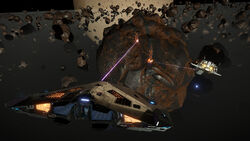
Mining duo
Mining involves five processes:
- Probing
- Fragmenting
- Collecting
- Refining
- Selling
It is important to note that the first four processes can overlap during a mining session, and must be carefully managed in order to maximize efficiency and profit.
Probing
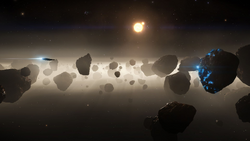
Asteroid probe
Elite Dangerous: Beyond Chapter Four (3.3) introduced new aspects to mining: using new tools and exploration mechanics, miners can investigate rings to locate the best spots to start their mining sessions, and then the best specific asteroids to probe and excavate for rewards.
- The Detailed Surface Scanner can analyze Planetary Ring Systems and highlight any resource-rich hotspots.
- The Pulse Wave Analyser can scan large areas within Planetary Ring Systems and highlight the most lucrative asteroids.
- The Prospector Limpet can analyze a single asteroid and provide in-depth composition data before excavating.
Seismic Charges
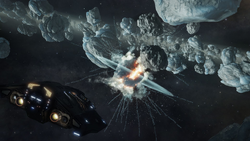
Python mining asteroid explosion
Currently there's one type of asteroid with a distinct shape and size that can be detonated. It's a medium sized rock, roundish "teardrop" in shape -or a pointy edge on one side and a fat bottom on the other. With the Pulse Wave Analyser it should always show a bright, brilliant yellow glow even as you approach it. There are fissures on the surface. Use the Seismic Charge Launcher to place Seismic Charges within the fissures. Then explode it to reveal valuable minerals.
Fragmenting
Make sure to bind a Mining Laser (preferably in its own firing group) just like you would do with any other weapon in the game. Fly within range (being 500 m) of the asteroid and blast away with the Mining Laser. You have to hold down the trigger for a while (depending on the quality of Mining Laser you have bought) before a fragment chips off.
Select the fragment of rock as a target. They are quite small and hard to detect visually but do show up as white contacts on your radar. When selected, you get details of the contents of the fragment, e.g. Bauxite (9.7%) Coltan (21.2%). Note that the mineral name which shows up first in the HUD doesn't necessarily represent the most valuable mineral! The mineral content is how much of a ton of cargo can be extracted from the fragment. E.g. if you scoop and process three 35% Indite shards you end up with 1 ton of Indite. Fragments range in mineral content from ~5% to ~65%. Asteroids contain 1 to 3 different minerals while fragments from the asteroids contain up to 2 of those minerals.
Collecting
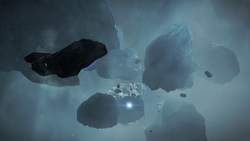
Asp collects asteroid minerals
Collecting fragments can be done with a cargo scoop or a collector limpet drone.
To collect with a cargo scoop, first, engage your scoop (just like you would with your landing gear or hardpoints), then fly slowly towards the target. Upon engaging the Cargo Scoop you will find that a blue box will have appeared on the lower left of your HUD. On there you should, if pointing at the rock, see an icon in the cross-hairs (the box). Continue to fly slowly towards the rock while holding the rock in the middle of the cargo scoop's cross-hairs until you have successfully acquired it.
Asteroid fragments are more difficult to scoop than regular cargo, as their movement is more complex (not to mention the fact that you want to avoid hitting an asteroid while you're focused on scooping!) For this reason, it's advisable to use very slow speeds of 15 m/s while scooping. Furthermore, fragments will "decay" over time, meaning they slowly lose integrity until they disappear, so do not mine more than you can collect!
To collect with a collector limpet controller you must purchase limpets ahead of time in any munitions store (the place you buy your ammo). Collector limpets have 2 modes: quick single-collection and autonomous area-collection. For mining, the area-collection mode is optimal. Limpets must bound to a fire group like a weapon.
To activate a limpet in area mode, be sure that no cargo or fragment is targeted. This is important as activating a limpet with a collectible item targeted will activate the limpet in single-collection mode. Once in area mode, the limpet will automatically collect any fragments a specific distance from you based on the class and rating of the controller. While this happens you can continue with other actions such as fragmenting, refining, and monitoring your surroundings. Use collector drones with caution near spinning asteroids, since their basic AI doesn't account for the movement of the asteroid. You can equip multiple collector drone limpet controls assuming you have enough internal compartments.
Refining
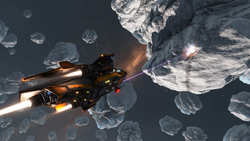
Diamondback mining
Once a fragment enters your cargo hold, it will be deposited in the refinery. It can be accessed on the right panel under cargo tab, then there is a refinery tab on the left column. The first bin is the depositing bin, where you will find your fragment. New minerals will attempt to drop into the refinery bins below. Depending on class your refinery will have between 1 and 10 of these bins.
Items that appear in the depositing bin will automatically "stack" into the refinery bins below if a refinery bin that already contains that mineral exists. It will also drop into empty bins automatically. If no bin is available, you will have to vent your refinery (see next paragraph). This will happen until the bin reaches 100% at which point it will be emptied, the leftover mineral will remain in the depositing bin, and 1 ton of cargo (one unit of whatever mineral you have collected) appears in your cargo hold. Once your cargo hold is full, you can return to a station and sell your goods.
You also have the option to "vent" the contents of your refinery. This is useful if you have a nearly-full refinery of bauxite and you find an asteroid with gold (or whatever else you prioritize). When no bin is available, minerals will not leave the depositing bin and will block it from accepting new fragments. When this happens you must either vent a refinery bin to free up space or vent the mineral from the depositing bin. NOTE: Doing this will destroy the mineral and you will not be able to recover it.
Selling
The value of a mineral is scaled to the supply/demand meaning that selling minerals where there are many other players selling the same mineral will result in a smaller profit per ton as demand for that item is low with so many suppliers. Systems that are both refinery economies and have an asteroid field will tend to give you a lower price compared to what you would get if you were to travel somewhere more distant to the source (source being asteroid fields). Also, checking the bulletin board is very important, since mining mission rewards can reach hundreds of thousands of credits. The most sought-after minerals in missions are painite, osmium and platinum.
Accepting Mining contracts at the Mission Board yields much more money for the mined commodities.
Styx is an excellent example of where we see a massive drop in prices. It has both mining equipment for sale, is very close to the spawn point for new players, has mineable asteroid fields and is a refinery economy (means it will have a constant demand for minerals to refine), it is therefore going to be very popular to sell minerals there which is going to lead to a price drop due to a saturated market.
Keep in mind that carrying valuable resources around attracts pirates and other players may also try to rob you. With mining lasers attached you will be less effective at defending yourself so don't lug rare metals around too long.
Resource Availability and Values
Commodities
This is a rough table on which minerals, metals, and chemicals are most valuable to mine. These prices will be lower or higher depending on demand in the station you're selling to. It can be helpful to screenshot the nearest station's metal, mineral and chemical market prices to ensure highest profit, since varying demand of different resources can result in great variation of profit. Note that some stations can buy Void Opals for up to 1.6 million, and Low Temperature Diamonds for up to 1.2 million.
| Minerals | Galactic Average Price (CR/T) | Available in Ring Type |
|---|---|---|
| Void Opals | 291,965 | Icy |
| Alexandrite | 272,130 | Metal Rich, Icy, Rocky |
| Grandidierite | 254,333 | Metal Rich, Icy |
| Musgravite | 245,479 | Metal Rich |
| Monazite | 237,936 | Metal Rich, Rocky |
| Serendibite | 222,540 | Metal Rich, Rocky |
| Rhodplumsite | 208,115 | Metal Rich |
| Benitoite | 194,647 | Metal Rich, Rocky |
| Low Temperature Diamond | 57,443 | Icy |
| Painite | 40,504 | Metallic, Metal Rich |
| Bromellite | 8.530 | Icy |
| Lithium Hydroxide | 5,644 | Icy |
| Bertrandite | 2,375 | Metallic, Metal Rich |
| Methanol Monohydrate Crystals | 2,282 | Icy |
| Indite | 2,088 | Metallic, Metal Rich, Rocky |
| Gallite | 1,821 | Metallic, Metal Rich, Rocky |
| Coltan | 1,319 | Metal Rich, Rocky |
| Uraninite | 836 | Metal Rich, Rocky |
| Methane Clathrate | 629 | Icy |
| Lepidolite | 544 | Metal Rich, Rocky |
| Rutile | 299 | Rocky |
| Bauxite | 120 | Rocky |
| Metals | Galactic Average Price (CR/T) | Available in Ring Type |
| Platinum | 19,756 | Metallic |
| Palladium | 13,295 | Metallic |
| Thorium | 11,860 | Metallic |
| Gold | 9,401 | Metallic, Metal Rich |
| Osmium | 9,136 | Metallic, Metal Rich |
| Praseodymium | 8,604 | Metallic, Metal Rich |
| Samarium | 8,090 | Metallic, Metal Rich |
| Silver | 4,777 | Metallic, Metal Rich |
| Cobalt | 648 | Rocky |
| Chemicals | Galactic Average Price (CR/T) | Available in Ring Type |
| Hydrogen Peroxide | 917 | Icy |
| Liquid Oxygen | 263 | Icy |
| Water | 120 | Icy |
Materials
This is a rough guide to which materials are available to mine. Materials cannot be sold for credits, but are used by Engineers and Technology Brokers and can be exchanged for powerful modifications and modules.
| Class I | Class II | Class III | Class IV |
| Carbon | Chromium | Arsenic | Cadmium |
| Iron | Germanium | Niobium | Mercury |
| Lead | Manganese | Selenium | Molybdenum |
| Nickel | Vanadium | Tungsten | Tin |
| Phosphorus | Zinc | Zirconium | Boron |
| Rhenium | |||
| Sulphur |
Pirates and other miners
Viper MkIV and asteroid minerals
Pirates can be a problem. They occasionally do a fly-by and scan you. They might even attack. You can prepare for this eventuality in several different ways:
- If you have brought some defensive weaponry of your own it may be possible to turn the tables on your would-be attacker, earning yourself a bounty payout in the process. Of course, rigging your ship for combat might reduce your cargo space, so you would have to travel a lot more between your mining site and the station every time your cargo hold is full.
- Jumping away into supercruise or hyperspace is also an option if you find yourself outmatched, although it might be frustrating having to abandon valuable asteroids you may have discovered. It is also important to remember that asteroid rings establish a mass-locking effect on your frame shift drive, necessitating that you clear the asteroid field to a sufficient distance before your FSD will begin charging. Asteroid belt clusters will not lock your FSD, but retain enough local mass to disrupt low-energy jumps. It is also necessary to align towards a sensible escape vector before your computer will engage the jump.
- If you're in a system controlled by a non-anarchic faction, resource extraction sites are often patrolled by security forces mobilized to defend miners and engage any wanted ships they detect. Ensure your ship's computer is set to 'report crimes committed against me' to enable a swift security response.
- Additional tip - You can mine planetary rings anywhere, even completely outside a Resource Extraction Site (RES)- just get close in supercruise, then lower your speed to minimum before hitting the ring. Hitting the ring at this speed will cause you to drop out of supercruise at the ring with no damage although you will not have police protection (usually). Alternatively, in a RES, fly 30 or more km away from the RES marker. You will not see any NPCs spawn again unless you go closer. It does not seem to make any difference to the quality of rocks you mine.
- Fast ships, such as those in the Krait family of ships, are capable of outrunning pirates. In fact, any ship with a speed of over 450m/s will outrun any pirate. The only exception to this are opponents encountered during a wing mission, as these may be engineered.
- If your ship has the option a Fighter Hanger can be a good option for defense since most of your hardpoints will be being used on mining lasers. Simply deploy a fighter as soon as you arrive and use it or order a crewmember to defend yourself. This could make the Keelback a decent early option, but its low cargo space with a fighter bay may prove an issue.
It's kind of a dirty trick, but if you see other NPC miners out there zapping away, it's usually worth it to mine the rock they're currently working on. They seem surprisingly good-natured about you grabbing their spot, even. Be careful not to accidentally shoot or crash into them however as you may provoke them; or gain a bounty.
Cooperative mining
A buddy and I have been fighting with ways to make deep core mining more efficient with the two of us. First we tried one of us with Seismic Charges while the other used the Abrasion Blaster, but found once a prospector limpet is on a rock it really bugs it out for the other person (seismic charge graphic and countdown do not show etc).[2]
Then we finally settled on a efficient strategy. One of us would fly in a bare-minimum mining ship with decent speed and low-mass equipped to find and crack rocks while the other would have a larger ship filled with collector limpets and a refinery.
For the miner, I bought an Asp Scout since it has lower mass and the hardpoints/internals perfect for deep core and surface mining. What's even better is with its two size 1 Abrasion Blaster hardpoints being so close together it's a guaranteed 2 minerals out of every surface material. I also fitted dual Seismic Charge Launchers just for the extra ammo (not sure if this works?). Here's my Asp Scout Mining Build.
My buddy was just rolling in a Anaconda with the most collector limpets and cargo space he could fit in it, and a 4A refinery.
So here's our routine:
- Asp Scout finds the next deep core rock
- Asp cracks rock and uses Abrasion Blaster to quick clean it from surface deposits
- Anaconda deploys all collectors and refines all ore
- As soon as all surface deposits are cleaned, the Asp Explorer flies on to find next deep core.
- Repeat until either A) Anaconda runs out of cargo which then we would go to the best selling station and split the cargo (not like this, though) or B) Asp is out/low of prospector limpets, at which point the Anaconda can spare some. Or C) Out of Seismic charges, which then requires a station trip to rearm.
So far it's been pretty successful. As long as I can have the next rock cracked by the time the Anaconda shows up we're golden. It's also an amazing sight seeing the collector limpets come pouring from the ship while I'm between the cracked 'roid plinking off surface ore.
Split Cargo
Ore holder sits in open space away from anything with a beacon on. The smaller ship either jumps into the bigger ship or fits more cargo space. The smaller ship jumps to the bigger ship and the bigger jettisons as much tonnage as the smaller one can carry. The smaller ship jumps to a station, sells/repeats.[2]
It's not so much the cargo space as it is the amount of collector limpets the smaller ship can control. The faster you can split cargo the better. The longest step of this whole process is waiting for your collectors to bring in cargo that was jettisoned. So I can deal with selling only 50T at a time as long as I can pick up that 50T within a reasonable time.
Notes
- Mining features were first added in the Beta 3 Update for Elite Dangerous, which was released on October 28, 2014.
- Mining was greatly expanded with new features and modules by Elite Dangerous: Beyond Chapter Four (3.3), which was released on December 11, 2018.
- Asteroid fragments will display on the ship's radar as grey boxes.
- Use the System Map to find systems with asteroid belts or rings that have the description "Pristine Reserves" and "Metallic".
- Mining in planetary rings is more effective as there are always plenty of nearby asteroids to choose from (unlike belts).
- For maximum profit, focus on mining highly valued metals or minerals (like Painite, Platinum, Palladium or Low Temperature Diamonds).
- Use collector drones to speed up efficiency.
- Use prospector drones to double the yield of asteroid fragments.
- If the asteroid's fragments have low concentration (below ±15%), don't waste your precious time and try a different one.
- Even if your cargo is full, you can still fill up the refinery to 100% per slot. When you return to a starport to sell your cargo, this frees up space and each full refinery slot will go into your cargo hold. Treat it as extra cargo space.
- Enabling Night Vision is useful especially when mining in the massive shadow of a planet.
- The material content (Low, Medium, High) does not affect the amount of metals, minerals or chemicals that the asteroid contains.
- Keep an eye on the fragments; in some cases, they will get themselves stuck inside the meteorites. This will make it so your collector limpets will launch themselves into the rock; destroying themselves. If you notice a drone die early quickly look out for this and add it to your exclusion list as soon as possible to avoid more limpet loses.
- You can craft additional limpets via synthesis and you are very likely to pick up the components for them while mining; however they are incredibly wasteful of Nickel, which is a common engineering material. Use this only in a pinch such as seeing rare materials with no drones.
- If you are only mining for access to Selene Jean's engineering then always go to planetary rings. You can still use prospector drones to increase yield but you will be instead looking for group asteroids so you can collect as much as possible as fast as possible as you generally won't be too concerned with profit in this scenario. In fact, more common ores may be desirable due to being able to refine them faster. Use as many collector limpet controllers as you can equip with as big of a refinery as possible as well to help out.
- Always avoid or run away from NPC pirates while carrying mining cargo unless piloting a ship that is combat capable or equipped with a Fighter Hangar. Pirates almost always use Hatch Breaker Limpets, which means dealing with them involves a high risk of partial or total cargo loss.






